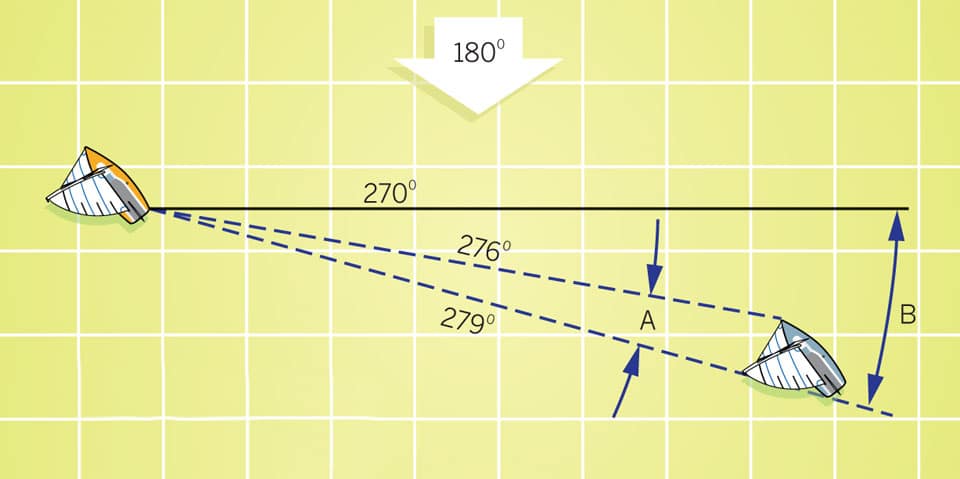
cross or tack
We’ve all been in situations where we’re to leeward and ahead of another boat, on the same tack, and we’re not certain whether we can tack and cross them. Whether the boat is a few lengths to weather or a quarter mile away, using crosswind and position lines can often help you make that decision. Case in point: In the summer of 2012, I was sailing TP52s with Quantum Racing in Palma, Spain. There, typically in the summertime, it’s a left-hand track—you start on starboard tack, get headed slightly, tack just before the layline and get lifted on port to the windward mark. In one race we had a good start and went chomping off on starboard tack. It was a long beat, so we were comfortable that we would be able to get to the boats just to windward of us. Our main concern was Rán, which was immediately to windward and about six boatlengths away. We started taking bearings on Rán and comparing those numbers to the crosswind. [A crosswind line is an imaginary line perpendicular to the true wind direction.] We had to figure out if, before we reached the layline, we would be able to tack and cross Rán. If that wasn’t to be the case, then our strategy would have to change dramatically.
When boats are on the same tack, such as our situation with Rán, bearings can be used to determine relative gains and losses. The next step is to use them to determine whether you can tack and cross an opponent. Whenever you’re taking a bearing on an opponent, be sure to target an equivalent point on that boat to where you’re sitting on your boat. If you’re on the transon, you need to sight off the transom of your opposition.
To keep the math simple, let’s say you’re sailing upwind on starboard tack in a steady southerly wind—true wind direction of 180 degrees. Your competition is on the same tack just to windward of you. The crosswind line runs 90 degrees to the true wind and establishes the “ladder rungs” of an upwind or downwind leg. In this example, the crosswind line to windward bears 270 degrees. You can judge the relative position of the competition by taking a bearing on them. This is called the position line. If the position line to the other boat is ahead of [i.e. lower than] the crosswind line, they’re ahead of you. If the position line is behind [i.e. greater than] the crosswind line, they’re behind. If the two are the same, then the two boats are exactly even.
Knowing whether you’re ahead or behind is only half the battle. You also need to know by how much. One way to figure this out is by measuring your opponent’s boatlengths in degrees on the compass, then dividing the difference between the crosswind and the position line bearings by that number. The final result is how many boatlengths you’re ahead or behind. A seat-of-the-pants way of doing this is to eyeball the distance using fingers on an extended hand—if the other boat is two finger-widths long and there are four fingers between the crosswind and position line bearings, then you’re two boatlengths ahead.
A final piece of the puzzle required to determine whether you can tack and cross is how many boatlengths you will lose in the tack. This changes with windspeed and, more importantly, sea state. Most boats will lose between 1.5 and 3 boatlengths in a tack.
Time to do the math. Remember: When you’re on opposite tacks from another boat and converging, you need to be one boatlength ahead of the boat you hope to cross. Here is an example: You’re ahead and to leeward; the true wind angle of the breeze is 180 degrees. The bearing to the other boat is 279 degrees and the width of your opponent’s boat is 3 degrees. Subtracting the crosswind bearing (270 degrees) from the position bearing to the other boat leaves you with 9 degrees. Dividing that by 3 puts you ahead by 3 boatlengths. Subtracting the two boatlengths lost during a tack leaves you with the one boatlength you need to cross, but no margin for error. To be safe, you’ll want to have at least a quarter to half length, if not more, depending on how variable the conditions are, in the bank before you can confidently report to the skipper than you’ll be able to cross.
You can use crosswind lines and position lines downwind as well to determine whether or not you can jibe and cross a boat that is on the same jibe. I use them only when there is at least seven boatlengths of lateral separation between boats. Any less and, because of the angles and perspective, it’s difficult to accurately determine how many boatlengths they are behind you.
To finish the tale with which I started this article, as we got about three-quarters of the way to the corner, with around 2 minutes left on starboard tack, the numbers on Rán showed us that we wouldn’t be able to cross them before reaching the layline. So we needed to change our exit strategy out of the corner. We tacked, they leebowed us, we tacked back to the left side again, then tacked onto the port layline, and when it was all over we crossed them by three boatlengths. The ability to know where we stood relative to our competition enabled us to take control of the beat and get the desired outcome.









